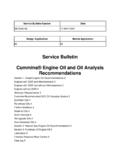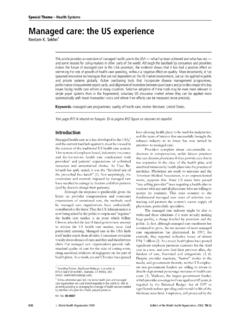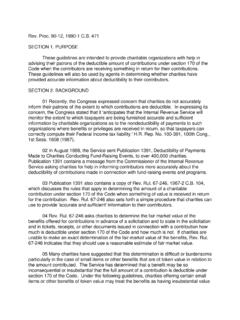Transcription of Methodology – Tendances carbone
1 Tendances carbone - Methodology January 2013 1 Methodology Tendances carbone CDC Climat Research publishes Tendances carbone , the monthly bulletin on the European carbon market (EU ETS). The objective of this publication is to provide our readers with analysis and information on the development of the European carbon price and its fundamentals. This paper provides further details on the indicators used in Tendances carbone and their calculation. Each month, the bulletin presents six groups of indicators: 1. EU carbon market: monthly summary 2. Energy 3. Production 4. Impact of temperature 5. Institutional environment 6. Carbon markets dashboard The data and Methodology used to calculate each of these groups of indicators is discussed below.
2 1. EU ETS: monthly summary Monthly trading volumes of EUA and CER The monthly trading volume is the total of all the daily transactions on the exchanges and OTC markets. We use Thomson Reuters to get the data from NordPool, EEX and GreenX, whereas for ICE Futures Europe we use data provided on its website. Prices of EUA and CER: Futures Daily settlement prices for contracts are provided by ICE Futures Europe. EUA CER price spreads Daily price spreads between EUA and CER is calculated from ICE Futures Europe data on contract. 2. Energy The purpose of this indicator is to evaluate changes in production costs of electricity generation due to variations in primary energy prices and therefore to give and indication of economic incentives to shift production capacity to modes of production which emit less CO2.
3 The Energy prices indicators correspond to the monthly average of the daily closing price of this following energy source (Thomson Reuters) - the prices of coal API#2 CIF ARA Month Ahead in USD/t; - the prices of natural gas NBP and TTF in /MWh; Tendances carbone - Methodology January 2013 2- the prices of Brent in USD/b; - the prices of base load German electricity, spot and Calendar 2013 in /MWh - the prices of base load UK electricity, spot and next season in /MWh From this, CDC Climat Research calculates: - two specific spread indicators based on the price of CO2, which refer to the marginal profitability of using coal-fired generation ( clean dark spread ) as well as using gas-fired generation plants ( clean spark spread ).
4 - the implied fuel switching price , the price of CO2 which would be required to equalize the returns to coal and gas and beyond which arbitrage opportunities toward the use of gas are possible. These indicators are calculated for Germany and the United Kingdom, which represent the main areas of arbitrage opportunity in the EU ETS. These following parameters are used for the calculation: For Germany - Net thermal Efficiency of a conventional coal-fired plant : 36 % - Net thermal Efficiency of a conventional gas-fired plant : 50 % - Emissions factor (CO2/MWh) of a conventional coal-fired plant: 0, 96 tCO2/MWh - Emissions factor (CO2/MWh) of a conventional gas-fired plant: 0, 37 tCO2/MWh For UK - Net thermal Efficiency of a conventional coal-fired plant : 35 % - Net thermal Efficiency of a conventional gas-fired plant : 49,13 % - Emissions factor (CO2/MWh) of a conventional coal-fired plant: 0, 98 tCO2/MWh - Emissions factor (CO2/MWh) of a conventional gas-fired plant.
5 0, 38 tCO2/MWh Calculation of clean dark spread The clean dark spread, expressed in /MWh, represents the difference between the price of electricity and the price of coal used to generate that electricity, corrected for the energy output of the coal plant. We calculate dark spreads by dividing the coal price per MWh in the chosen currency by the coal plant efficiency rate expressed as a percentage (CO2 impact is not included). Then, we subtract the result from the electricity futures contract price. Dark spread = Power price - (Coal price per MWh / Coal plant efficiency rate) Our clean dark spreads are calculated by subtracting the carbon emission costs (adjusted with the impact of CO2 gas) from the dark spreads: It is calculated for each day as follows: Clean dark spread = Dirty dark spread Carbon price coal CO2 emissions factor The monthly clean dark spread published in Tendances carbone corresponds to the monthly average of daily clean dark spreads.
6 Calculation of clean spark spread The Clean spark spread, expressed in /MWh, represents the difference between the price of electricity and the price of natural gas used to generate that electricity, corrected for the energy output of the gas-fired plant. We calculate spark spreads by dividing the natural gas price per MWh in the chosen currency by the natural gas plant efficient rate expressed as a percentage (CO2 impact is not included). Then, we subtract the result from the electricity futures contract price. Tendances carbone - Methodology January 2013 3 Spark spread = Power Price - (Natural gas price per MWh / Natural gas energy efficiency factor) We calculate our clean spark spread by subtracting carbon emission costs (CO2-adjusted) from spark spread.
7 It is calculated, for each day, as follows: Clean spark spread = Dirty spark spread Carbon price gas CO2 emissions factor The monthly clean spark spread published in Tendances carbone corresponds to the monthly average of daily clean spark spreads. Calculation of the CO2 allowance switching price The switching price is an indicative CO2 allowance price which indicates when a switch from coal to natural gas or from natural gas to coal is economically advantageous to an electric power producer. Mathematically, this indicator is the fictional daily price of CO2 that would establish equality between the clean dark spread and the clean spark spread. In the short term, it is advantageous to switch from: - coal to natural gas, when the daily CO2 price is above carbon switch - natural gas to coal, when the daily CO2 price is below carbon switch It is calculated for each day as follows: Switching Price = MWhgastCOMW hcoaltCOMW hcoaltMWhgast/)(/)(/)(cos/)(cos22 With: Cost (gas): Production cost of one MWh of electricity on base of net CO2 emissions of gas in /MWh Cost (coal): Production cost of one MWh of electricity on base of net CO2 emissions of coal in /MWh tCO2 (coal): Emissions factor (CO2/MWh) of a conventional coal-fired plant: 0, 96 tCO2/MWh tCO2 (gas): Emissions factor (CO2/MWh) of a conventional gas-fired plant.
8 0, 37 tCO2/MWh The price of the monthly switch price published in Tendances carbone corresponds to the monthly average of daily switch prices. 3. Production The objective of this indicator is to analyze firstly the evolution of electricity generation in Europe by energy sources (fossil fuels, nuclear, hydro and renewables), and secondly, changes in production in other industrial EU ETS sectors European electricity production This indicator is compiled from monthly data published each month by the International Energy Agency (IEA) in its monthly electricity survey bulletin . The data are aggregated for 20 European countries which are involved in the EU ETS. It includes only the European OECD countries and does Tendances carbone - Methodology January 2013 4not include Romania, Bulgaria, Slovenia, Latvia, Lithuania, Cyprus, Malta, Liechtenstein, Estonia.
9 These data are provided with a delay of three months. European industry production index The European industrial production indicator shows the monthly index (base 100 =2005) of industrial production excluding construction provided by Eurostat. Data are seasonally adjusted. The European industrial production index indicator published in Tendances carbone corresponds to the index of production of all industries for the month M 2 for the EU-27. For instance, in March 2011, Eurostat publish January index. 4. Climpact Metnext Weather Index European temperature index Climpact Metnext provides the Metnext Weather indices for the following 18 countries: Austria, Belgium, Germany, Denmark, Spain, Finland, France, United-Kingdom, Hungary, Ireland, Italia, the Netherlands, Norway, Poland, Portugal, Sweden, Slovakia and Slovenia.
10 This national business-climate index is defined as the average daily temperature of the regions making up the country, weighted by the population of these regions, which gives a good approximation of the weight of regional economic activity. This index , expressed in C, is calculated for each country as follows: == =NiiNiiipp11 With: N: Number of regions in the country under consideration; ip: Population of region i; i : Average temperature of region i during the month under consideration, in C. Calculation of the Tendances carbone European temperature index: The European temperature index is equal to the average of the national temperature indices for the 18 countries, weighted by the weight of each country in the total volume of distributed allowances. This European temperature index is calculated as follows: == =4141jjjjjQQT With: jQ: Number of allowances allocated by the NAP in country j; j : National temperature index of country j.







